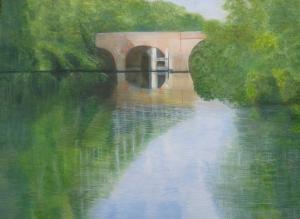20% off all products! Sale ends tonight at midnight EST.
January 6th, 2015 - 05:01 AM

There are no rules when it comes to landscape painting. Youíre free to approach your painting in whatever way you want to. Every artist has their own preferences and thatís what makes painting in general so exciting. Here are four general tips for you to consider if you want a bit of help painting landscapes:
1. Appreciate colours
One of the most wonderful things about nature is the huge numbers of colours. There are all sorts of shades, hues and tones of colours out there to be seen. Pay attention to colours that feature prominently in the landscape Ė if youíre painting a field, for example, note all the different shades of green. Likewise, if youíre painting a snowy landscape, observe all the different varieties of white. Whatever type of landscape youíre painting, take some time to explore the colours in depth. Experiment by mixing different colours on your palette to try and match the colours in the landscape before you. Make note of what colours to mix to produce the colours youíre going to use in your painting. I find it always helps to get some colours prepared beforehand.
2. Include what you want
Thereís no obligation for you to include every single tiny detail you see before you. Thereís nothing stopping you including everything if thatís what you want to do, but at the same time itís your painting and youíre free to create your take on the landscape. You could include the parts of the landscape, such as rivers, trees and hills, while omitting smaller details such as animals, bushes and rocks. I like to focus on a few particular parts of the landscape that capture my attention the most for whatever reason. I feel that my paintings are more likely to capture other peopleís attention if I include the things that caught my attention.
3. Create what you want
Your landscape painting is your unique representation of a scene. By all means, be creative and use your imagination when deciding what goes into your painting. Youíre using the landscape before you as a basis for your painting, but thereís nothing stopping you adding your own touches here and there. Rearrange elements to suit your vision Ė if you think a tree, for example, would look better on top of a hill rather than at the bottom of a hill, place it at the top of the hill. If youíre painting a really famous, well-known landscape, you want to be sure to include whatever makes it famous, but donít be afraid to add things and move things about.
4. Decide what should have prominence
You want your landscape painting to draw people in. If you give something prominence, thatís going to stand out and will draw people in more. If you paint everything with the same amount of detail, thereís not going to be anything outstanding to really capture peopleís attention. A good way of having something stand out is to paint whateverís in the foreground with a lot of detail, using less and less detail the further into the background you get. Alternately, you could choose to focus on something thatís not necessarily in the foreground but further away. Itís entirely up to you.
Comments
There are no comments on this blog. Click here to post the first comment.